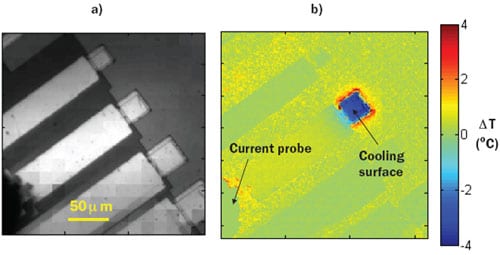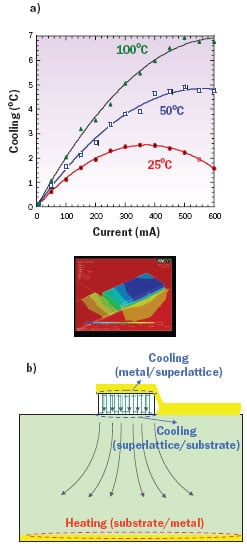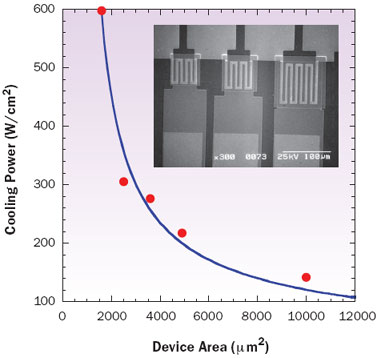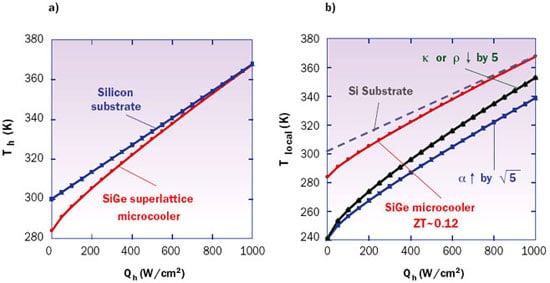Introduction
Temperature control of microelectronic devices has become more important in recent years. Device miniaturization and higher switching speeds have increased power dissipation substantially. Limiting the maximum die temperature has resulted in an increase of packaging complexity and cost. The failure rates resulting from electromigration and oxide breakdown are exponentially dependent on temperature. Thus, the thermal management of devices plays a vital role in integrated circuit (IC) reliability.
Another distinguishing characteristic of an IC’s temperature profile is the uneven power dissipation, which leads to “hot spots”. The temperature inside a microprocessor chip could vary 5~30°C from one location to another [1]. The large temperature gradient causes chip failure due to the temperature-dependent leakage power, crosstalk noise between cells and interconnect delay problems, etc. Mostly, the thermal design requirements are driven by the peak temperatures. Therefore reducing or eliminating hot spots could alleviate the thermal design requirements for the whole package.
Thermoelectric coolers (TECs) based on bulk BiTe are commonly used for optoelectronic device temperature stabilization. However, they cannot satisfy the increasing thermal requirements of ICs because of their relatively large size and low cooling capacity on the order of 5-10 W/cm2. Recently ultra compact and high cooling power density BiTe-based thermoelectric coolers with leg lengths on the order of 5-20 �m have been demonstrated [2, 3]. However, because BiTe is not compatible with silicon integrated circuits, these devices must be placed on the back of the IC chip, which limits localized cooling. In the following sections, we will review thin film silicon-based microrefrigerators that can be monolithically integrated inside a chip.
Thin Film Microrefrigerators
Thin film microrefrigerators have been studied extensively over the past few years [4]. Microrefrigerators using superlattices have shown especially promising cooling performances. Superlattices are periodic multilayer structures with layer thicknesses on the order of 1-50 nm. For example, Venkatasubramanian et al. demonstrated that a BiTe/SbTe superlattice with a ZT~2.4 could reach cooling power densities larger than 500 W/cm2 [2]. Zeng et al. demonstrated that SiGe/Si superlattice microrefrigerators with a cooling power density of 600 W/cm2 are possible [5].
Why are superlattice structures useful in thin film microrefrigerators? Generally, thermoelectric materials are characterized by the figure-of-merit Z, which is given by the equation Z = α 2/ ρk, where α is the Seebeck coefficient, ρ is the electrical resistivity and k is the thermal conductivity. If Z is increased, the maximum cooling and the refrigerator efficiency increase. Therefore, it is very important to use materials with higher Z value for refrigeration.
Different from conventional thermoelectric coolers, superlattice microrefrigerators can also benefit from thermionic emission in heterostructures. In the thermionic emission process, hot electrons from a cathode layer are selectively emitted over a barrier to the anode junction. Since the selective emission of hot electrons corresponds to evaporative cooling, strong electron-electron and electron-lattice interactions tend to restore the quasi-equilibrium distribution in the cathode by absorbing energy from the lattice, which provides cooling at the emitter junction [6].
At low current densities electron filtering in multibarrier structures can improve the effective Seebeck coefficient without reducing the electrical conductivity and an order of magnitude improvement in ZT is predicted [7]. Furthermore, short period superlattices can also reduce lattice thermal conductivity [2]. Independent of material improvement, the unique geometry of microrefrigerator devices with small localized cold junctions and large hot junctions can result in a high cooling power density of 100’s W/cm2 even with bulk silicon substrates 0.5 mm thick [8]. In this article, we focus on SiGe/Si superlattice microrefrigerators because of the relatively easy integration with most microprocessors.
 |
Figure 1(a). Thin film SiGe/Si superlattice microrefrigerator.
Figure 1(b). Thermal image of microrefrigerator under operation.
Device Structure and Cooling Performance
Figure 1(a) shows various sizes (40 x 40 – 100 x 100 �m2) of thin film SiGe/Si superlattice microrefrigerators fabricated using batch integrated circuit fabrication techniques. A typical SiGe/Si microrefrigerator consists of a 3�m thick superlattice layer with the structure of 200 x (3nm Si/12nm Si0.75Ge0.25), doped to 5e19cm-3, a 1�m Si0.8Ge0.2 buffer layer with the same doping concentration as the superlattice, and a 0.3�m Si0.8Ge0.2 cap layer with doping concentration of 1.9e20 cm-3. By changing the superlattice period, thickness, doping concentration, and device size, the cooling performance of SiGe/Si microrefrigerators can be optimized.
The superlattice material is grown using molecular beam epitaxy (MBE). This technique allows a precise layer by layer growth at a rate of 1-2 microns per hour. Large scale MBE growth of GaAs chips for cell phones and laser diodes for compact disc applications have been demonstrated. The epitaxial growth is done simultaneously on 5 – 6 wafers, each 2″- 4″ in diameter. After the research phase, where material optimization is done and inherent issues affecting electron and heat transport at nanoscale are understood, other techniques such as chemical vapor deposition could be used for larger scale production of microrefrigerators.
Thin film microrefrigerators differ from bulk thermoelectric coolers because each thin film microrefrigerator device is composed of a single element instead of an array of p-type and n-type legs arranged electrically in series and thermally in parallel. The cooling power density is only a function of the element leg length and it is independent of the number of elements. The main reason for array structures is the tradeoff between operation current and voltage, which can reduce heat losses in metal leads. In order to remove a small hot spot, a single element thermoelectric cooler is much easier to fabricate and integrate on top of a chip, but there are more parasitic heat loss mechanisms that can limit the maximum cooling.
Figure 1(b) shows the temperature distribution on top of microrefrigerator measured using the non-contact thermoreflectance technique. One can see the uniform localized cooling on top of the microrefrigerator. Figure 2 (a) illustrates the typical cooling curves (maximum cool down below ambient versus supplied current) for 60 x 60 �m2 microrefrigerators. The solid curves are from commercial finite element 3D electrothermal simulation results [9] and the dots are experimentally measured data.
 |
Figure 2(a) Microrefrigerator’s cooling versus supplied current.
Figure 2(b) Diagram showing current flow and heat exchange in a single element microrefrigerator. Inset shows the calculated temperature profile.The Figure 2 inset shows the temperature distribution of a 60 x 60 �m2 device at its maximum cooling at room temperature. It includes the effective thermoelectric effects at the metal/superlattice and superlattice/silicon interface as well as all parasitic non-ideal effects, such as Joule heating, metal/semiconductor contact resistance etc. From Figure 2 (a), we see that thermal modeling agrees well with the experimental results. The microrefrigerators could offer a maximum cooling of 7°C at zero heat load at 100°C ambient temperature.
According to the theoretical simulation, the current limitation of the superlattice coolers comes from the contact resistances at the metal/semiconductor and cap/buffer interfaces, which are on the order of 10-6 Ωcm2. Detailed modeling predicts that 15-20°C of cooling with a cooling power density exceeding several thousand W/cm2 is possible with the optimized SiGe superlattice structures [10, 11].
 |
Figure 3. The maximum cooling power density versus device size. Inset shows the fabricated thin film heater on top of the microrefrigerator.The experimental results shown in Figure 3 illustrate the maximum cooling power density of different size microrefrigerator devices. To measure the cooling power density of microrefrigerators, we fabricated a thin film heater layer on top of the device, which could work as both a sensor for temperature measurements and a heat source (see Figure 3 inset). During these measurements, we heated the heater using a constant current; at the same time we also measured the cooling of the microrefrigerators using a thermocouple or the resistance value of the heater.
By increasing the constant current to the heaters, more heat load was added on top of the refrigerators, and the cooling ΔT was decreased. The maximum cooling power density of the device was defined as the maximum heat flux per area that the device could absorb when ΔT = 0. The maximum cooling power density for a typical microrefrigerator with a device size of 40 x 40 �m2 is 600 W/cm2 as indicated in Figure 3. Transient measurements have shown that microrefrigerators can provide fast cooling with a response time of 20-40 microseconds [11].
Microrefrigerator Optimization in a Packaged IC Chip
So far, we have described the cooling performance of microrefrigerators without considering the package effect. In real packaged integrated circuits, the thermal resistance of the heat sink and that of the thermal interface material can significantly affect the cooling performance of microrefrigerators. To study this, an electrothermal model was developed to calculate the hot spot temperature with and without a microrefrigerator in a packaged IC.
In this calculation, the superlattice thickness and its operation current are optimized to minimize the hot spot temperature. We assumed a 50 x 50�m2 SiGe/Si superlattice microrefrigerator was fabricated at the center of the silicon substrate (1 mm x 1 mm x 500�m). A package thermal resistance of 6 x 10-5 m2K/W is assumed. On top of the microrefrigerator the same size hot spot is placed. The heat flux at the hotspot is assumed to be ten times larger than the background heating applied everywhere else on the chip.
Figure 4(a). Hot spot temperature for packaged IC chip with and without Si/SiGe microrefrigerator.
Figure 4(b). The effect of material properties on hot spot temperature.Figure 4(a) shows the relationships between the hot spot heat flux, Qh, and the hot spot temperature, Thotspot, for the model with and without a microrefrigerator. As can be seen from the graph, the superlattice microrefrigerator can lower the Thotspot value below what was obtained from the model without a microrefrigerator (standard IC package), although the effectiveness of thin film microrefrigerator is reduced as Qh increases. By embedding the thin film superlattice in a packaged IC, a 7.5°C reduction in hot spot temperature can be achieved at a heat flux Qh = 300 W/cm2. The optimum superlattice thickness for cooling is ~10 microns. The microrefrigerator will consume a power of 30 mW compared to the power dissipation in the whole chip of ~300 mW.
For most materials, a higher ZT translates directly to either a larger cooling temperature difference (ΔT) or a higher cooling efficiency. As shown in the equation for Z, it is possible to change it by controlling three material properties: α, ρ and k. To understand how each parameter affects the cooling performance, when one parameter is varied to increase Z, the other two parameters are kept constant.
Figure 4(b) shows the predicted cooling performance of microrefrigerators with various ZT values (T=300K, room temperature). For the purpose of comparison, the plot for the microrefrigerator with ZT = 0.125 (current ZT value for SiGe/Si) is shown in the same graph. A large reduction in hot spot temperature can be seen when ZT is improved. We can see that the effect of decreasing ρ and k on Thotspot is identical, but the effect of increasing α is much larger than that of decreasing ρ and k. This result indicates that the Seebeck coefficient of thin film materials is a more important factor to maximize the cooling performance for 3D superlattice microrefrigerator in a packaged chip [12].
In practical implementations, in the short term it may be difficult to change the fabrication process of the IC’s to include monolithically integrated SiGe microrefrigerators with active devices. One can bond a microrefrigerator chip at the back of silicon substrate. For example gold-gold fusion bonding, which has low thermal interface resistance, can be used. Since the two chips are made from the same silicon material, there are no issues related to the thermal expansion coefficient mismatch. In such two-chip integration, the embedded microcooler inside the composite substrate provides a means to actively control the temperature of the hot spot.
Initial results showed only a cooling of 0.4°C at the hot spot [13]. The problem is due to high thermal conductivity of silicon and even with 50 microns thick silicon IC, the cooling of the embedded refrigerator could not be localized at the hot spot. A trenched structure inside the silicon substrate was used to improve the localized cooling and a 1.7°C cooling with cooling power density of ~110 W/cm2 was demonstrated for a hot spot of 130 x 130 �m2 [14].
Conclusion
Both experimental and simulation results show that Si/SiGe superlattice microrefrigerators offer localized spot refrigeration with a maximum cooling of 7°C or a maximum cooling power density exceeding 500 W/cm2 at 100°C ambient temperature. These properties make microrefrigerators good candidates for hot spot cooling. Analysis for a packaged IC chip showed that for an optimized refrigerator with improved material properties (ZT~0.6), a temperature reduction up to 30°C can be achieved for a hot spot with a 1000 W/cm2 heat flux. One should note that for 3D integrated microrefrigerators in realistic packages, the material figure-of-merit, ZT, is not necessarily the best performance indicator to evaluate the maximum cooling or cooling power densities.
References
- Chrysler, G., “Building Blocks for Thermal Management of Electronics,” Proceedings, Next-Generation Thermal Management Materials and Systems Symposium, Dallas, TX, Oct. 2002.
- Venkatasubramanian, R., Siivola, E., Colpitts, T., O’Quinn, B., “Thin-film Thermoelectric Devices with High Room-Temperature Figures of Merit,” Nature, Vol. 413, 2001, pp. 597-602.
- B�ttner H., “Thermoelectric Micro Devices: Current State, Recent Development and Future Aspects for Technological Progress and Applications,” Proceedings, 21st International Conference on Thermoelectrics, IEEE, Piscataway, NJ, 2002, pp. 511-518.
- Fan, X., Zeng, G., Croke, E., LaBounty, C., Ahn, C., Huxtable, S., Majumdar, A., Shakouri, A., Bowers, J. E., “SiGeC/Si Superlattice Microcoolers,” Applied Physics Letters, Vol. 78, 2001, pp. 1580-1582.
- Zeng, G., Fan, X., LaBounty, C., Bowers, J., Croke, E., Christofferson, J., Vashaee, D., Zhang, Y., Shakouri, A., “High Cooling Power Density of SiGe/Si Superlattice Microcoolers,” Proceedings, Materials Research Society Symposium, Vol. 691, 2003, pp. 147-152.
- Shakouri, A., Bowers, J., “Heterostructure Integrated Thermionic Coolers,” Applied Physics Letters, Vol. 71, 1997, pp. 1234-1236.
- Vashaee, D., Shakouri, A., “Improved Thermoelectric Power Factor in Metal-Based Superlattices,” Physical Review Letter, Vol. 92, No. 10, 2004, pp. 106103-1.
- Zhang,Y., Zeng, G., and Shakouri,A., “Silicon Microrefrigerator,” Journal of IEEE Transactions on Components and Packaging Technologies, to be published in 2006; Wang, P., Bar-Cohen, A., Yang, B., Solbrekken, G.L., and Shakouri, A., “Analytical Modeling of Silicon Thermoelectric Microcooler,” Journal of Applied Physics, to be published in 2006.
- ANSYS Release No. 7.0, ANSYS, Inc., Canonsburg, Pa., 2003.
- Vashaee, D., Christofferson, J., Zhang, Y., Shakouri, A., Zeng, G., Labounty, C., Fan, X., Bowers, J., Croke, E., “Modeling and Optimization of Single-Element Bulk SiGe Thin-Film Coolers,” Microscale Thermophysical Engineering, Vol. 9 (1), 2005, pp. 99-118.
- Shakouri, A., “Nanoscale Thermal Transport and Micro Refrigerators on a Chip,” to be published in the Proceedings of IEEE, 2006.
- Zhang, Y., Zeng, G., Bar-Cohen, A., and Shakouri, A., “Is ZT the Main Performance Factor for Hot Spot Cooling Using 3D Microrefrigerators?” IMAPS on Thermal Management, Oct. 26th-28th, 2005, Palo Alto, CA (Student Competition Award).
- Zhang, Y., Shakouri, A., Bar-Cohen, A., Wang, P., and Yang, B., “Experimental Demonstration of Microrefrigerator Flip-Chip Bonded with IC Chips for Hot-Spot Thermal Management,” Proceedings, InterPack’05, July 17th -22nd, 2005, San Francisco, Ca.
- Zhang, Y., Zeng, G., Shakouri, A., and Bar-Cohen, A., “Enhanced Hot Spot Cooling Using Bonded Superlattice Microrefrigerators with Trench Structure,” submitted to the Journal of IEEE Transactions on Components and Packaging Technologies, 2006.











